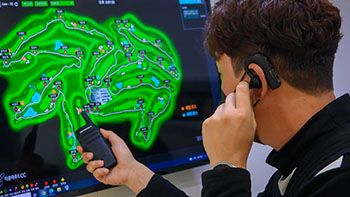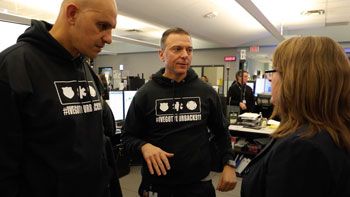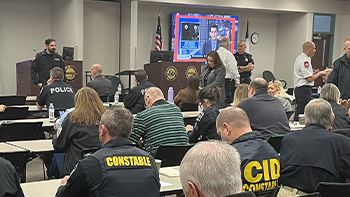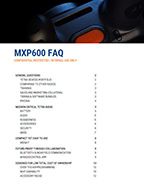


Customer success stories
We build and connect technologies to help protect people, property and places. Discover how we're inspiring, uniting and solving for safer.
















A shared vision of safety and security
Public safety agencies, enterprises and communities around the world have joined us in the pursuit to help protect people, property and places. Their trust and support enables the critical collaboration needed for a proactive approach to safety and security.
100%
top U.S. cities
are solving for safer with us
95%
top U.S. school districts
are solving for safer with us
95%
top U.S. hospitals
are solving for safer with us
80%
top stadiums
are solving for safer with us
Statistics above cite data from top U.S. cities based on population, top U.S. school districts based on enrollment, top U.S. hospitals based on number of beds and top U.S. stadiums based on capacity.
Our customer stories
Explore our customer case studies and discover how organizations around the world are solving for safer by relying on our safety and security ecosystem.
results
Filters
Filter by
Region
Industry
Products

Spanish town council unifies communications with WAVE PTX™
Illescas Town Council chose WAVE PTX™ to connect its police force and municipal workers using reliable coverage, robust radios and intuitive functionality.

Reliable communications for an historic motoring event
WAVE PTX™ technology helped ensure communications for the London to Brighton Veteran Car Run remained clear and reliable over a wide area.

National airline deploys MOTOTRBO™ Capacity Plus
With its migration to MOTOTRBO™ Capacity Plus, Air Mauritius is now benefiting from robust communications coverage and excellent audio quality on rugged radios.

Enhancing safety in a remote New Zealand environment
Motorola Solutions is providing seamless communications capabilities to search and rescue teams operating in Milford Sound, New Zealand.

Greater safety and security for Catalonia prisons
Catalonia’s Department of Justice has introduced MOTOTRBO™ infrastructure into its prisons to provide reliable and scalable communications systems.

Future-proof, mission-critical communications at UK prison
G4S is using a MOTOTRBO™ Capacity Plus Single-Site System to increase security and improve worker safety at HM Prison Rye Hill.

Critical communications for major global summit
The 26th United Nations Climate Change Conference utilised MOTOTRBO™ and WAVE PTX™ technology for communications during the event.

Integrated safety solutions for Hong Kong shopping mall
How a scalable-on-demand Smart Management Solution is improving workflows and saving costs for a shopping mall in Hong Kong.

Scaling up safety and guest satisfaction with WAVE PTX
Scaling up safety and guest satisfaction with WAVE PTX service and TLK 100’s providing high-quality voice, uncompromised safety and security management.

Securing communication in the cloud for Sumter County
Hear how Sumter County in Florida tested cloud technology from Motorola Solutions to cost-effectively add redundancy to their ASTRO P25 radio system.

York Regional Police prioritizes cybersecurity
Paulo Da Silva, York Regional Police Chief of Police, discusses the importance of cybersecurity for public safety and why they chose to partner with Motorola Solutions.

Next-generation communications for Glendale Police
APX NEXT P25 Smart Radio technology is helping the Glendale Police Department stay connected and keep its community safe.

Enhancing campus safety with automated systems
The Northwest Independent School District in Texas has ushered in a new era of safety across its campuses with an automated technology suite from Motorola Solutions.

Safety at scale for leading global logistics company
Wallenius Wilhelmsen, a leading provider of logistics solutions, deploys a Motorola Solutions technology ecosystem at its port in Belgium.

Increasing operational efficiency and safety for oil giant
Czech Republic oil giant ČEPRO introduced a MOTOTRBO™ two-way radio system to improve workflows and interconnectivity for its workers.

Upgrading safety and security in the Vatican City State
The Gendarmeria Vaticana - the Police Force of the Vatican City State - upgraded to MOTOTRBO™ Capacity Max with WAVE PTX™ for crystal-clear communications and scalability.

Halving the number of 9-1-1 call transfers in Utah
Call transfers were a problem in Utah, so the state implemented Motorola Solutions’ NG9-1-1 Call Routing, which has reduced call transfers by over 50%.

Digitalizing retail store communications with WAVE PTX
Motorola TLK 100i radios interconnect store employees with the push of a button to reach the right person or group for a fast response.

East African security company deploys WAVE PTX
Seneca EA equipped guards on patrol with TLK 100 radios providing reliable connectivity and crystal-clear audio along their tour routes.

Unforgettable experiences powered by Motorola Solutions
Watch as Motorola Solutions provides seamless communications behind the scenes at an event venue.

FIS deploys MOTOTRBO IP Site Connect at world championships
FIS/GST teams communicate across wide area with MOTOTRBO IP Site Connect system at the Freestyle Ski, Snowboard and Freeski World Championships

Integrated technology makes airport safer and smarter
The Safety Reimagined ecosystem is helping the Belgrade airport to effectively manage potential or escalating situations, proactively protecting property and assets.

Transforming waste management operations with WAVE PTX
The WAVE PTX solution seamlessly integrates with existing communication systems, such as two-way radios, smartphones, and other devices.

Top level security for a multi-client petrochemical site
The MOTOTRBO Capacity Max system is designed to provide an open, flexible and scalable solution and is capable of evolving in accordance with the customer’s needs.

WAVE PTX elevates standards at Sun Kwang Newport terminal
WAVE PTX hand-held and vehicle-mounted radios were critical in the elimination of shadow areas for seamless, uninterrupted clear voice communications around the port.

Safe hospitals ecosystem for proactive threat management
Safe hospitals ecosystem was a game-changing approach that allowed SSM Health to proactively address situations, making security more efficient and effective.

Unified communications geared for all-terrain performance
MOTOTRBO Capacity Plus Digital Radio System and WAVE PTX integration utilizing LTE connectivity unified team communications, connecting staff working in different states.

Tee Cloud Country Club enhances safety and service with WAVE
Tee Cloud Country Club navigates rough terrain and enhances safety and service standards with Motorola Solutions' broadband push-to-talk WAVE PTX service and TLK 100

Pronto Biometrics and Ticketing apps
In the field, Pronto gives officers fast access to operational databases, Biometrics and Ticketing apps.

Digital transformation for disaster response with WAVE PTX
Leveraging push-to-talk/multimedia communications and high-speed capacity networks for mission-critical incident ground communications using WAVE PTX

MOTOTRBO™ IP Site Connect increases safety and efficiency
The MOTOTRBO IP Site Connect system delivers robust mission-critical communications in remote and potentially hazardous environments.

Seamless communications for better animal welfare
Seamless, resilient and reliable communications with MOTOTRBO ION and WAVE PTX paves the way for AWL NSW inspectors to safely and effectively care for animals.

Unified communications at Port of Tauranga
MOTOTRBO Capacity Plus trunking solution supports voice communications, and an ecosystem of technologies such as data, analytics, recording, and location capabilities.

How public safety communications is moving to the cloud
The path to the cloud began with a vision that included greater mobility and flexibility, both in how they communicate with the public as well as first responders.

UK security organisation deploys WAVE PTX
WAVE PTX has been successfully integrated into the existing MOTOTRBO Capacity Plus system for nationwide, reliable, secure PTT (Push-ToTalk) communications.

Leading Swiss security company deploys WAVE PTX™
VüCH AG chose WAVE PTX and TLK100 radios for a cost-effective, scalable, countrywide Push-to-talk over Cellular (PoC) communications and employee tracking solution.

Reliable, scalable communication solutions in MIQ facilities
Motorola Solutions' multimedia WAVE PTX subscription service, TLK 100 and TLK150 two-way radios provided seamless, unified communications enabling clear audio nationwide.

MOTOTRBO™ Capacity Max for Indonesian motor racing circuit
Pertamina Mandalika International deploys MOTOTRBO Capacity Max system to ensure that operational teams have clear, reliable communications.

Real-time communications in the wilderness
Riverbend Campground and Canoe Rental chose the WAVE PTX Radio wireless service with integrated TLK 100 Radios to solve their communications challenges.

Delivering seamless, reliable communication using WAVE PTX
Delivering seamless, reliable transportation communications for an international sports event in Japan with a fleet of 5,000 broadband push-to-talk WAVE PTX LTE radios

Netherlands country-wide vehicle recovery with WAVE PTX™
TLK 100 WAVE PTX radios enable tow truck drivers with fast, reliable PTT communications, increasing efficiency, improving service and enhancing worker safety.

Spanish automobile testing facility deploys radios, cameras
MOTOTRBO™ radios and AVIGILON™ cameras deployed at a Spanish test circuit facility to deliver optimal communications, operational efficiency and overall safety.

University college deploys MOTOTRBO™ IP Site Connect System
University of Oxford, Keble College enjoys MOTOTRBO system for crystal-clear, reliable, multisite communications enabling coordinated, efficient operations.

Campus boosts security with Pelco camera solution
Berlin, Germany campus employs a range of Pelco cameras and accessories, allowing campus leaders to better detect and respond to incidents in real-time.

Perry Township implements safe schools solutions
School safety is dramatically boosted with integrated technology suite including threat detection, real-time situational awareness and instant communication.

Wembley Stadium enhances safety during matches and events
Highly reliable, flexible and scalable MOTOTRBO™ Capacity Plus delivers mission-critical communications and noise cancelling technology when it matters most.

Driving safer outcomes for road users via data utilization
National Heavy Vehicle Regulator implements a mobile-first system to centralize data collected on-road and make it available in real time.

MOTOTRBO™ enables emergency communications at Italian plant
MOTOTRBO™ enables broadcast of announcements and management of communications during emergencies and compliance with security and confidentiality standards.

3M implements communications system for warehouse logistics
Sydney, Australia 3M fulfillment center leans into Motorola Solutions communications system and wearable picking devices to help streamline operations.

AMEY deploys WAVE PTX™ for Transport Scotland
WAVE PTX provides the right balance of optimal communication clarity and seamless coverage, while being flexible to grow and adapt to customer needs.

County council and events company deploy WAVE PTX™
New functionality helps make Wiltshire Council’s and Events Crew’s mobile workers feel more included and connected with reliable, clear communications.

Publier reduces response times while increasing safety
MOTOTRBO™ radios and network offers reliable coverage, strong encryption and crystal clear audio across Publier, France to keep officers informed and safe.

WAVE PTX™ for new, state-of-the-art hospital buildings
Optimal Push-to-Talk (PTT) communication solution to cover subterranean locations as well as scale across multiple sites across central London.

Unifying operations for efficient ANZ waste management
New communication network covers a much wider area and more territories, ensuring the capacity to serve the customers they have today and into the future.

Boosting emergency disaster response with WAVE PTX™, TLK 100
Japanese department store Hakata Daimaru equips employees with nationwide broadband coverage, devices with crisp audio and user-friendly interfaces.

UK fire and rescue service deploys MOTOTRBO™ radios
Reliable, clear, mission-critical incident ground radio communications helps teams work more efficiently in potentially life threatening situations.

Improve safety and incident command decision making
Suburban Illinois fire departments upgrade to the personnel accountability solution and standardize firefighter accountability across 30 fire departments.

Indiana hospitals stay ahead of threats with MOTOTRBO™
Leading-edge radio system offers Indiana hospitals many safety features to protect officers, improve emergency preparedness and response, and secure the campus.

Great Manchester Fire and Rescue deploys MOTOTRBO™ radios
Fire and Rescue Service now has clear, effective and robust communications, allowing firefighters and support personnel to work more efficiently and safely.

African energy company upgrades to MOTOTRBO™ Capacity Max
Delivering improved site coverage, added functionality and crystal-clear mission-critical communications at its GNL and GPL units and headquarters.

Real-time alerts helping schools in Snohomish County
Snohomish County 911 is using Rave Mobile Safety technologies to help keep educators and students safer when incidents occur inside schools.

Bolstering community crisis responses in Canada
The Downtown Community Safety Partnership in Winnipeg, Canada uses Rave Mobile Safety’s AppArmor to record and monitor its interactions with the community.

Building resiliency across higher education and healthcare
AppArmor provides North Shore University Hospital with what it needs to enhance its emergency preparedness and customize management protocols.

Peel Regional Police PremierOne Go-Live
Watch the recap of the successful implementation of Motorola Solution's PermierOne CAD system for Peel Regional Police's Dispatch Center.

Driving the future of plant safety and efficiency
With one seamlessly integrated technology ecosystem, Logan Aluminum has completely reimagined its campus security and productivity efforts.

Security technologies integrated in the Quay Quarter Tower
Integrated voice communications and workforce tracking solution improves security at Quay Quarter Tower in Sydney.

University leverages Rave to swiftly respond to outbreak
Rave Mobile Safety helps ensure the safety and security of college staff and students - ranging from everyday incidents and severe weather to rare occurrences.

Informing the community of imminent weather and emergencies
The University of Vermont feels confident in their ability to keep their campus community safe and informed with Rave Alert.

Oklahoma boosts safety and communication during emergencies
Oklahoma’s Norman Public Schools help protect the school community by leveraging Rave Mobile Safety to enhance communication and collaboration.

AstraZeneca launches mass communications as force multiplier
Rave technology allows the AstraZeneca command center to manage multiple communications streams targeting specific buildings and groups within the facility.

Rave aids Seaboard Foods during and after COVID-19 outbreak
Rave’s messaging capabilities quickly notified employees about COVID-19 testing results and were also helpful when it came to sharing companywide announcements.

Blue Bird drives workplace safety and employee engagement
Factory employees are able to receive concise, critical, immediate communication that concerns their personal safety.

Fluor Federal Petroleum Operations adds mass notification
Recognizing the need to automate and improve paper-based control room operations, Fluor upgrades web communications, integrated emergency notification, mapping.

The future of requesting city call services
Fort Worth, TX, implements 3-1-1/government contact center solution to provide transparent and encompassing responses to customers’ non-emergency service requests.

Better communication leads to faster response times in Texas
Rave tools enhance Montgomery County's call centers’ ability to respond to unfolding emergencies by providing new ways to communicate with citizens in distress.

Saranac Community Schools: Safer schools within reach
Saranac implements an integrated system that includes video security, radio alerts and access control systems.

Keeping Hutto's schools safe with the VB400 body camera
Hutto Independent School District (ISD) relies on the VB400 body camera every day to capture evidence and foster trust in the school community.

Fostering trust in Hobart, OK with the VB400 body camera
Discover how Hobart Police Department uses the easy-to-operate, rugged VB400 body camera to improve transparency in their rural community.

WAVE PTX Keeping Devotess Safe at Yadadri Temple in India
WAVE PTX simplified the existing network of devices with the speed and interoperability PTT radios, connecting users with rich audio, text, photo or video data.

WAVE PTX and Evolve deliver business-critical communications
WAVE PTX and Evolve LTE deliver secure cloud-based business-critical communications that improve safety and enhance productivity at Singapore’s Pulau Bukom island

WAVE PTX enhances shuttle bus safety, security and efficienc
Drivers are using WAVE PTX and easy-to-use Evolve LTE Handhelds for reliable, instant PTT Communications to keep the kindergarten workers and parents informed

NKP Empire Ventures boosts productivity with WAVE PTX
NKP Empire Venture, a Bangalore food & beverage company boosts productivity by over 20 percent with WAVE PTX enabling the chain to continue with its pan-india expansion.

WAVE PTX, Building safer and more productive operations
WAVE PTX is increasing connectivity at the plant so it can maintain its competitiveness while ensuring a production environment that is safe and secure for its employees.

Revolutionising town efficiency with reliable communications
WAVE PTX is maintaining the operations of a city with a population size of over 600,000 residents which requires efficient coordination and seamless communication

WAVE PTX provides reliable coverage and instant connectivity
WAVE PTX provides reliable coverage and instant connectivity increasing productivity by 50% because of the instant connection to all our departments within the plant.

Royse City ISD increases security with new solutions
Future-proof security solution achieves top grades for fast-growing school district.

Royse City ISD increases security with new solutions
Future-proof security solution achieves top grades for fast-growing school district.

customer story -apx next title
customer story -apx next desc

customer stories - two way radios title
customer stories - two way radios desc

UAT 14267 - Video security control
Configure for UAT testing - Discover how Hobart Police Department uses the easy-to-operate, rugged VB400 body camera to improve transparency in their rural community.

Critical communication
Card 1 Test Scenario 4 (L&E,Mining, Retail F&E) last modified 1 rank 1

Two way radios
Card 2 Test Scenario 4 (L&E,Mining, Retail F&E) last modified 2 Rank 6

Police camera Accessories
Card 3 Test Scenario 4

Portable radio access title updated
Card 4 Test Scenario 4 (L&E,Mining, Retail F&E) last modified 3 rank 2

Education title
The information entered on this tab is used to populate the customer stories card used by multiple components on the site, including our Customer Stores page desc
AT&T Bellboy
Customer-stories-dynamic-cards-description
wireless infrastructure and RFID solutions
Customer-stories-dynamic-cards-description
test_industry title upd
test_industry desc

Customer-stories-page-original
Customer-stories-page

Customer-stories-page
Customer-stories-page updated by QA team

Customer-stories-page-original
Customer-stories-page

Connected technology helps Nampa police do more with less
Nampa PD uses connected technology to boost officer safety, improve response times and reduce crime. Learn how integrated systems create a safer community.

Education title - Testing DTENG-15917 attempt 21
Retest 2 - The information entered on this tab is used to populate the customer stories card used by multiple components on the site, including our Customer Stores

Communication title
The information entered on this tab is used to populate the customer stories card used by multiple components on the site, including our Customer Stores page desc

Customer-stories-page
Customer-stories-page updated by QA team

New CS Page - DTENG-15917
New CS Page - DTENG-15917

Test CS for Jon - DTENG 15917 - Jon
Brand new story for Jon

Dynamic tag
test decsription

Dynamic card
Dynamic card description

Hutto schools' safety enhanced by VB400 cameras
Hutto ISD uses VB400 body cameras across 13 campuses, ensuring safety and trust for its 10,000 students, faculty and administrators. See how they protect their community.
Show:
Before it was the facade of ‘we think we're safe.’ Today, because of what we've done through the partnership [with Motorola Solutions], there's not a much safer high school setting in the U.S.
Patrick Mapes
Superintendent, Perry Township Schools
In my 25 years in government, this is the singularly most outstanding public safety program I’ve come across. What we’ve put together here in partnership with our community, with Motorola Solutions, and with all of our vendors is really special.
Kevin Phelps
Glendale, AZ, City Manager
The new [body worn] video technology will capture valuable incident footage that provides an objective record to promote transparency and accountability while also helping to keep our officers and communities safe.
Neal Donohoe
Superintendent, City of London Police
Motorola Solutions’ technology is truly helping us to ‘put the public in public safety’ to create a safer Tasmania.
Chair, Mr David Daniels OAM
Crime Stoppers Tasmania
In critical moments where every second counts, first responders know that their radio provides a lifeline, keeping them safe and connecting them to urgent support and back-up at the press of a button.
Wolfgang Müller
Head of Dept Design & Operations of Critical Comm Infrastructures, Austrian Ministry of the Interior
